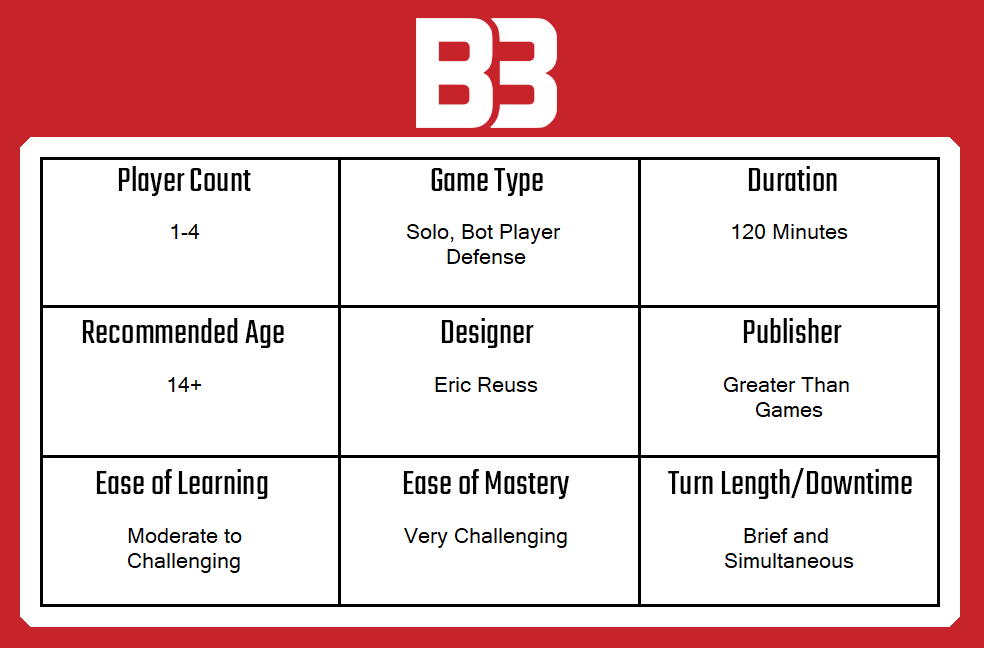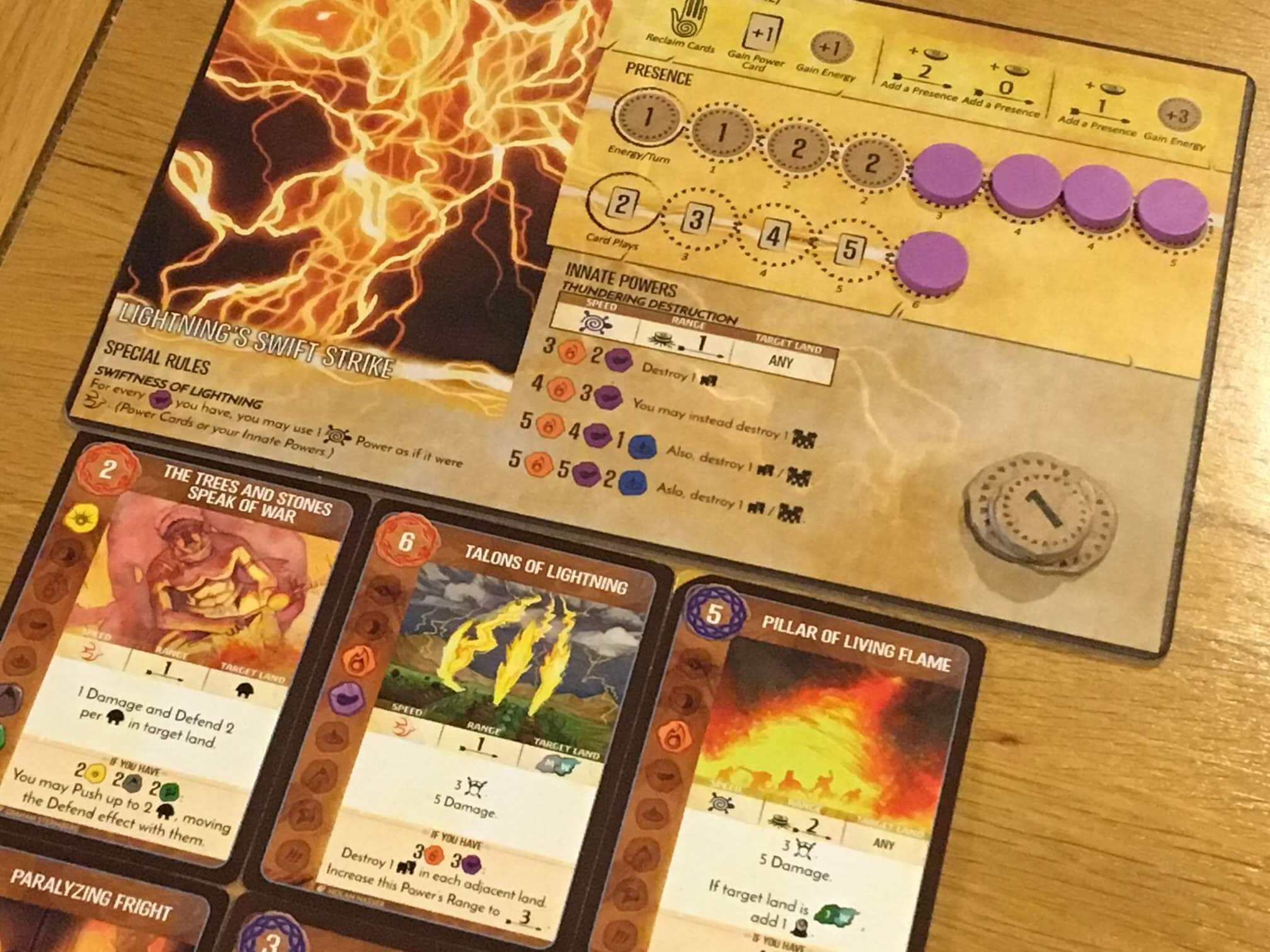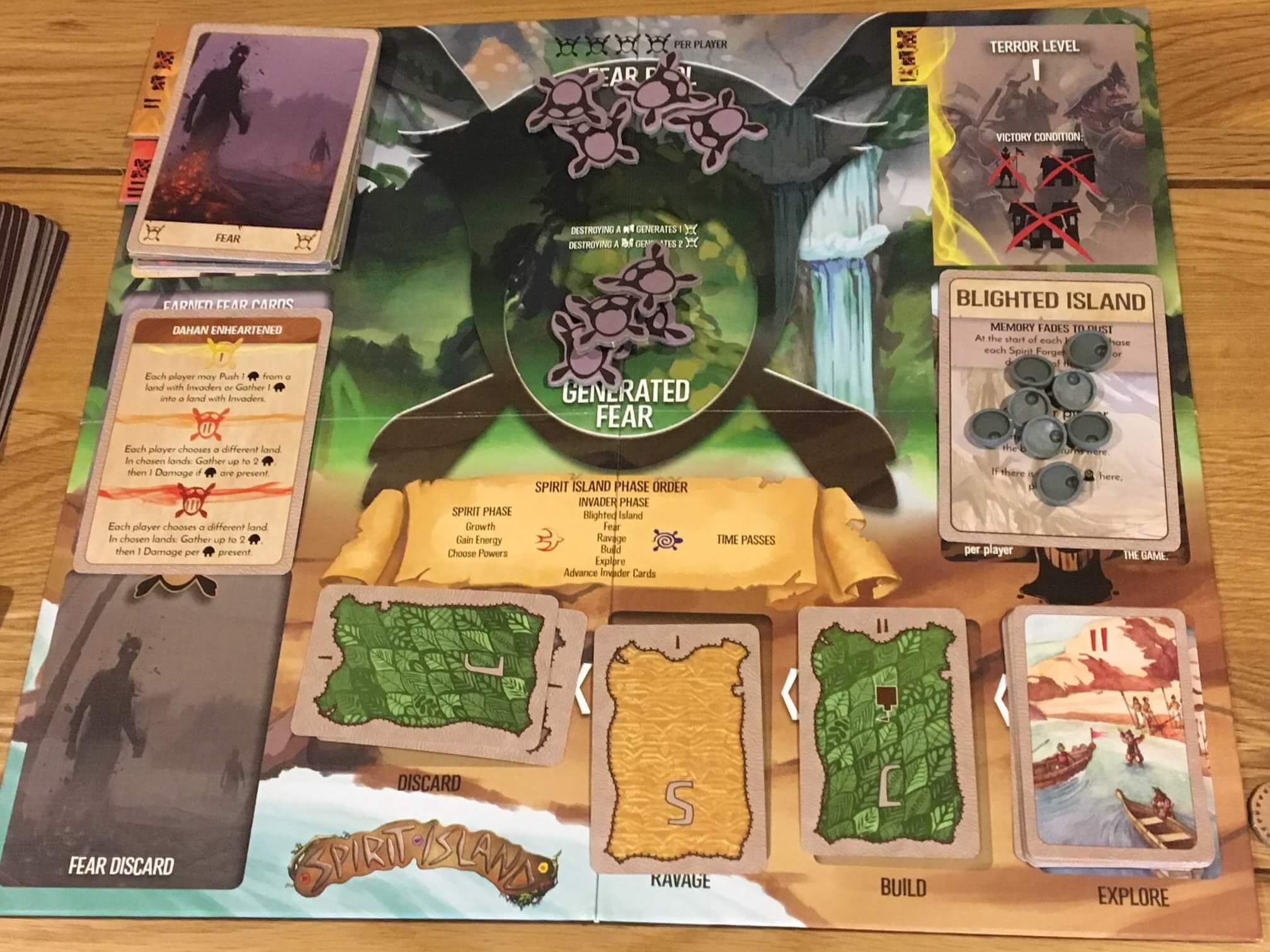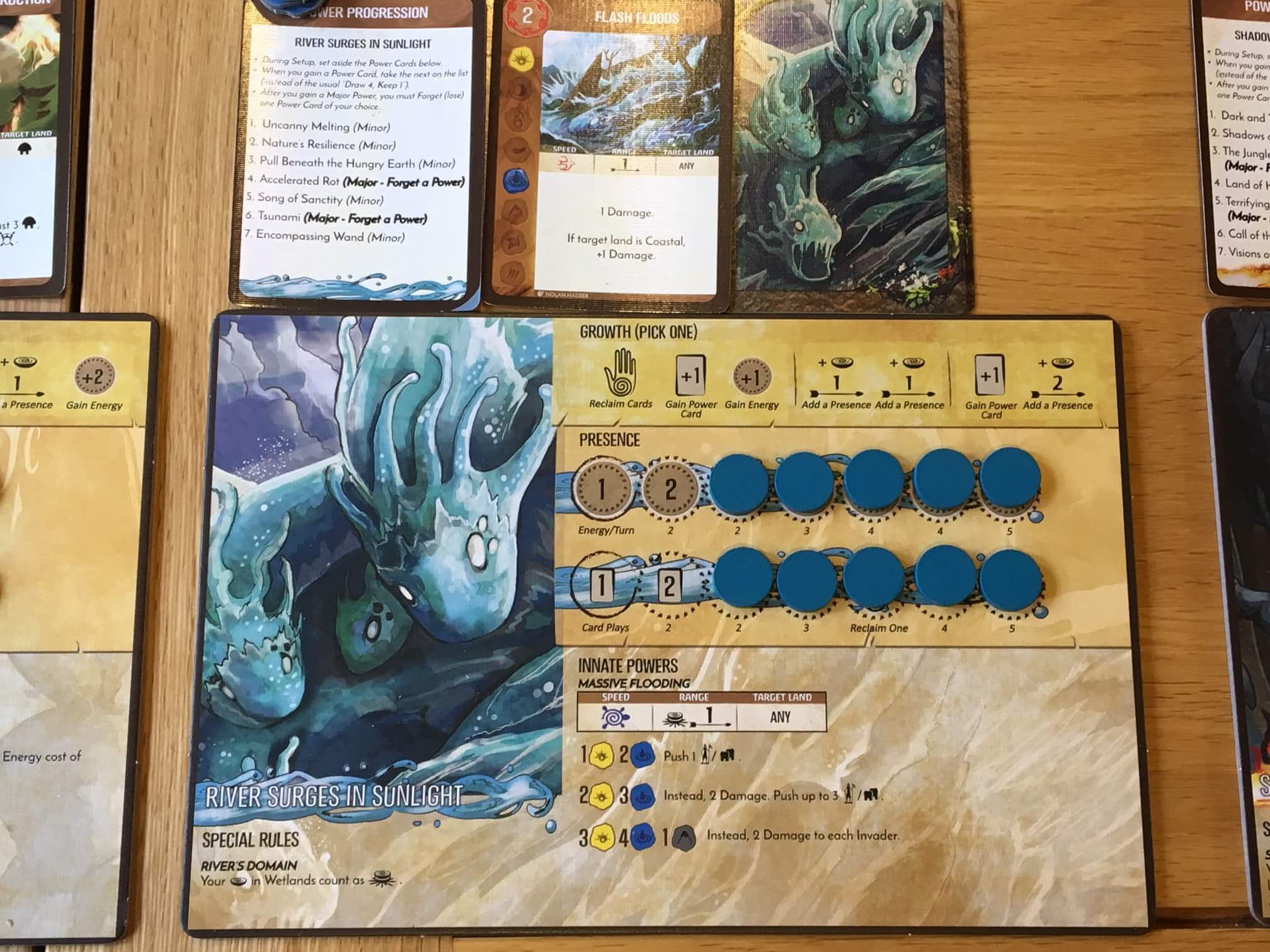Spirit Island and Jagged Earth Expansion review – Righteous fury

Whilst there has been much backlash about board games with colonial themes from the tabletop community in the last year or so, few designers or publishers have been willing or able to capture that sentiment and represent it in a game of their own. The most successful of these, as far as I know, is Spirit Island, which does so in spades.
I’ve recently been sent a copy of the game, along with a partial prototype of the upcoming Jagged Earth expansion, which adds a staggering amount of new content to a box that is already fit to burst. So, if you’ve been wondering whether the settler-smashing antis of Spirit Island are more gimmick than gameplay, keep reading.
Overview
In a rare reversal to the established norm, Spirit Island has a very straightforward theme, presented in a game that is at least mid to heavy in mechanical structure. Simply put, the objective of Spirit Island is to purge the never-ending stream of chalk-white settlers from the sacred island of the Dahan, who represent more or less any of the Pacific island cultures to have suffered at the hands of European colonisation. Clearly, this is a mildly controversial theme — but only because the majority of players may be white folk who might find themselves uncomfortable with doing what needs to be done.
Considering that I can probably list over thirty games that focus on (or at least feature) the colonisation of native lands by European powers, I think it’s fairly reasonable that at least one should tell the opposite side of the story. Sometimes, you just have to make your point clear and I think Spirit Island does so, without apology.
In fact, not only does Spirit Island make its point, it does so with a ridiculous amount of panache. Rather than depicting a grim and probably futile guerilla war between poorly armed native people and their more powerful European foes, Spirit Island has the players take on the role of various deities — each one of them a celebration of life, death, nature and the base instincts of man. I don’t know which, if any, are based on real gods, but each of them is as fully featured as if they were still revered today, with their own backstory and thematic approach to gameplay.
This setup gives Spirit Island the fairly unusual angle of being a one-to-four-player, cooperative game featuring numerous different setup conditions as well as various ways to affect the difficulty. In all connotations, Spirit Island is fairly hard, whilst if you set it up to be knowingly difficult, it can be nigh-on unwinnable. The four different (dual-sided) map tiles, the different deities (which I guess I should call spirits from here on out) and several different scenario options all add to the difficulty recipe, but the game is clear about how to set up for your first few games and vary the level of challenge to suit your player base. Spirit Island is one of the most deeply strategic, puzzling games I’ve ever played, so it lends itself well to a solo player controlling two or more spirits, or in multiplayer with a focused, experienced group.
Whilst all the images you’ll see in this review relate to the base game, I’ve also been testing two of the spirits from a brand new expansion called Jagged Earth, which looks likely to hit Kickstarter on October the 16th. I’ll discuss Jagged Earth in more detail later in this review, but unfortunately because I am playing with printed components, I don’t have anything to show you as such.
It’s worth noting that if Spirit Island sounds appealing to you at a base level, there is already an expansion available (Branch and Claw) which I haven’t played, but by all accounts, it’s fair to say that Greater Than Games has already demonstrated its willingness to support Spirit Island on a long term basis.

Components
When it comes to components in Spirit Island, there’s most certainly too much to list in the traditional sense without boring the pants off you. That said, the production quality is very high, the written instructions and examples are well presented and detailed and there’s more than enough plug-in and add-on content that I’d be surprised if you could see every combination in fewer than about fifty games. As it stands now, I’ve played about ten games (one with each spirit, including those from the expansion) and I’ve faced each of the invaders, each of the blight cards and several map combinations. My personal experiences have been very different each time because of the one, two or three other spirits I was playing alongside and who was controlling them.
The four modular board pieces are thick and attractive. One side has clearly labelled regions (as pictured) and the other is slightly more subtle and thematic, showing more of a photorealistic, painterly visual style. The eight spirit boards in the base game are of a similar quality, with one side covered in flavour text, playstyle and set-up information and the other providing a player mat with two tracks and an almost mind-boggling amount of information on it. A further large board is used to place several game-state decks and markers on, including the fear and invasion decks, the island blight status and the current fear level, plus how much fear has been generated. On the main board, the player places the stark invaders in the form of plastic explorer, town and city miniatures, as well as plastic corruption tokens and the more natural-looking Dahan settlements (which are made from wood, or at least made to look as though they are).
Supporting these central boards and tracks are numerous cards and tokens, most of which I won’t go into in detail over, but needless to say, all of them are of exceptional quality. In particular, I’d like to focus on the spirit decks and the minor and major power decks that help to expand them, which introduces a deckbuilding element to an already incredibly rich soup of gameplay mechanics.
Every power card (whether it be in the spirit-specific decks or either of the shared ones) has fantastic artwork, with some highly evocative themes — sometimes depicting a bit of violence, but always aptly named and thought-provoking. ‘The Jungle Hungers’, ‘Rouse the Trees and Stones’ and ‘Wrap in Wings of Sunlight’ are just a few of my favourite examples. These imaginative and beautiful names match perfectly with the even more rousing names used for the spirits themselves, which include such titles as ‘Shadows Flicker in Flame’, ‘Vital Strength of the Earth’ and my personal favourite, ‘River Surges in Sunlight’. Words can be powerful, and Spirit Island knows it.
There’s more, too. The base game includes three specific invaders and a few different possible scenarios in which they can attack the island. In a normal game, invaders spread out based on the draw of cards, but with a named enemy (including England, Sweden and Prussia in the base game) or a scenario (like Blitz) the invaders have a more focussed, usually harsher agenda that introduces new challenges. All of this complexity is presented in a single, fairly large manual, but credit where it’s due — whilst Spirit Island verges on being very heavy from a decision-making perspective, the manual and supporting player aids make it a doddle to learn at a basic structural level.

Turn structure
On that note, it’s not really hard to teach Spirit Island but, as I keep saying, it’s very hard to teach Spirit Island. A turn is broadly split between spirit and invader phases, but thanks to the mechanical ingenuity of the game, the order in which things happen each turn is actually the most attention-demanding feature for players.
At least a few things are certain, thankfully, and one of those is that each turn begins with Growth. A spirit chooses one of the three Growth actions at the top of their board. This usually involves taking one or more presence disks from either track on their board and placing it onto the map based on the rules of the Growth action. It may also involve drawing a new power, gaining energy or reclaiming all of the cards that have already been played on earlier turns.
After Growth, the players gain energy (equal to the topmost track on their board) and may decide to use a combination of card and innate powers, the latter of which are printed on the player mats. Players can use as many cards as they can afford to pay for, up to the limit printed on the second track shown on their player board. Growth serves several purposes, but whenever you use it to place your presence on the board, you’re also increasing your energy generation and ability to play cards, so considering how to expand is one of the first important decisions you’ll make in Spirit Island.
Once you’ve decided which cards you’d like to use, you’ll want to check whether they are fast (with a bird symbol) or slow (with a tortoise symbol). If slow, the power will come into effect after the invader phase; if it is fast, it activates immediately. I’m not going to explain innate abilities in detail, but they are powered by the various symbols on each card played — match enough symbols and you can cast the innate power effectively as a bonus.
Once you have resolved fast powers (I’ll talk a lot more about what actually happens with powers later), the invaders take their turn. There are three steps to this — Explore, Build and Ravage — and all of them are driven by the same deck of cards.
The Explore card is the face-up card on the top of the invaders deck, whilst the Build card has a slot next to it and the Ravage card a slot next to that. Each card shows a kind of terrain on the board and depending which slot it is in, something will happen to all spaces of that terrain type. On spaces matching the Explore card, you place explorer miniatures; on the Build locations, either towns or cities; whilst on the Ravage locations, the invaders deal damage to the native Dahan or the land.
When ravaging happens, all explorers, towns and cities deal damage, which will firstly remove any Dahan (who can each take two damage) and then damage the land. For each two damage the land receives, you take a corruption token from the blight card and place it onto the damaged space. If the blight card runs out of corruption tokens, it flips and confers a negative effect onto the players (such as being forgotten about, which reduces their presence).
After the invaders ravage, the Dahan do fight back, dealing two damage each — but bear in mind that any who were killed by the invaders don’t get to make an attack, so moving Dahan around the map to create favourable combat scenarios is all part of the strategy for certain spirits. After ravaging, each of the invader cards moves along one, so the Ravage card is moved into the discard pile, whilst the Build card moves into the Ravage space and the Explore card moves into the Build space.
Now the invaders have explored, built and ravaged the land, fear cards and any slow powers cast by the spirits will be resolved. You can probably imagine now why the way the turn structure plays out is so important to the tactics of success in Spirit Island, since the players will always know which lands will be built on and ravaged before it happens. Before powers resolve, any accumulated fear cards take effect. As a brief aside, at the beginning of every game, nine fear cards are drawn randomly and stacked, with two cardboard dividers placed after the third and sixth card. Each of these dividers represents a fear level — the more fearful the invaders are, the easier it is for the spirits to win. Again, this makes generating fear a legitimate tactic for some spirits, since they can burn through the fear deck very rapidly. Each fear card in itself usually conveys a number of different effects, all of which are powerful.
With all of the invader actions, spirit powers and fear or blighted island effects now resolved, play returns to the Growth phase and so it continues. I mentioned before that fear levels make the game easier to win and this is because the default win condition is to clear the island of all invaders, which is very hard (if not impossible). As the fear level increases, the players need only remove all towns and cities or just all cities, which makes the task considerably easier.
The turn overview I’ve given here is very much a whistle-stop tour of what takes place in Spirit Island and I should note that this game includes many, many ways to break the normal convention, change the sequence of play or otherwise break the rules in accordance with powerful effects and abilities.

Game experience
Honestly, how much you enjoy Spirit Island is likely to be a combination of how appealing its theme is to you and how much you like the kind of heavy, multi-layered, puzzle-based gameplay it is built around. It’s not competitive in any way, but it’s very, very challenging and it is capable of taking players to the polar opposite spectrums of frustration and excitement in equal measure. Without wanting to sit on the fence about it, I think Spirit Island is just incredible, so let me break it down for you as best I can.
Firstly, imagine that playing with each of the eight spirits is a completely separate puzzle in its own right — some move invaders and Dahan around the map in advantageous ways, some deal direct damage but do little else, one buffs the Dahan but has little direct capability. One is strong along the shoreline, whilst another is exceptional at defending, but extremely slow to act and build up their strength. Now imagine that each faction, each scenario and each shuffle of the invader deck is also its own, slightly randomised puzzle. Now overlay the challenge of solving that particular puzzle by overlaying it with the one presented by your chosen spirit, or the wildly different way in which several spirits play at the same time. That’s Spirit Island — it’s massively complex to master and in some connotations, it’s probably unwinnable. I certainly lost probably sixty to seventy percent of the games I played.
However, if you drape this incredibly complicated set of moving pieces in a singular, credible theme (that of colonial oppression) and you bind it together with a simple concept (the faith that the Dahan place in their spirit guardians) it becomes wholly more palatable. It is possible to see Spirit Island as simply a very complicated lock that has to be unpicked (and if that’s how your brain works, you should see it like that) but it’s so much more when you play it as a desperate struggle between an oppressed people and a foreign invader. Even in loss, it’s still possible to walk away from a game of Spirit Island with a different perspective not just on what makes a complex board game, but also on the bigger picture of the human journey from where we started to where we are now. It’s okay to be proud to be English, but that doesn’t mean we should be proud of everything we’ve done.
Thinking less philosophically, Spirit Island would be much less powerful if it were a bad game, or even if it were a lighter game that didn’t demand so much from players. It does create lasting stories over the course of a game, but it also allows for moments of ingenuity and sparks of brilliance on a turn-by-turn basis, regardless of the final outcome.
There are few board-game experiences that can top three players working together to use exactly their last bits of energy to buff one spirit, cast two fast spells here, push the Dahan over there, then queue up two slow spells in just the right way to prevent taking one more point of corruption, which would have ended the game. There are definitely a lot of moving parts here (deckbuilding, resource management, countering the programmed aspects of the opposition etc.) but the engine really sings once you can get it moving.

Jagged Earth expansion
Whilst I am going to attempt to provide as much detail as I can about the upcoming Jagged Earth expansion, let me just remind us both that the two spirits I have access to are just a quarter of those in the expected final version. In addition to ‘Many Minds Move As One’ (a spirit who introduces beast tokens) and ‘Finder of Paths Unseen’ (a spirit who often ignores range restrictions and has a lot of control over other pieces) I have also received several of the new aspect cards (which change the four entry-level spirits in the base game) and a new pair of island boards.
Although this might just be the tip of the iceberg, my understanding is that Jagged Earth will also include six more spirits, two new adversaries (I don’t know which nations, but the Netherlands, Spain or Portugal can have five pounds of my money) and an absolute tonne of new power, event, blight and fear cards. The data sheet I received also indicated that a new way to set up the board will be included and will enable islands to be setup in an archipelago formation, with new rules for island adjacency and so forth. There will obviously a range of new tokens and bits and pieces to support all this and I wonder if there might be the possibility of five- or six-player options, although that’s not mentioned anywhere.
As for the content I did receive… well, let me just say that both ‘Many Minds Move as One’ and ‘Finder of Paths Unseen’ only add to the complexity of options I’ve already described. I found Many Minds to be easier to actually play with, since the idea of adding beast tokens to the board and using them mostly to create fear felt quite natural and straightforward. Finder of Paths Unseen is certainly harder to play with at first, but arguably more powerful, since she has unparalleled reach among all spirits. I found this worked well with other spirits that could bestow abilities onto her to capitalise on her positional benefits, or if she could pick up an early offensive power or two.
The aspects — which essentially just sit on top of the player cards for the four most basic spirits — are an area I have played with less, but having used a few of them and reviewed a few others, they seem to have the overall effect of making the starting spirits slightly more powerful. Whether I am misreading the intentions of the aspects or I’m just wrong about what they do, I’m not sure. Looking at the most basic of them — ‘Move as Twin Storms’ (which becomes the basic ability of Lightning’s Swift Strike) is incredibly cheap to activate with only two, very common elements needed for a powerful return that allows up to two slow powers into fast ones. Another aspect belonging to the fear-generating spirit ‘Shadows Flicker Like Flame’ simply adds strife tokens (another new addition) whenever presence is placed — this kind of passive ability is really powerful, in my opinion.
In short, and being unfairly flippant, Jagged Earth looks set to be what I could consider to be a ‘more of the same’ expansion for experienced, dedicated players. That doesn’t mean that I don’t think it will be worthwhile, though — on the contrary, this is a ‘shut up and take my money’ kind of situation as far as I’m concerned. Adding eight new spirits is just an immense feat and I can’t imagine how Greater Than Games have come up with eight different ways to play, in addition to the ten already out there. With that said, the two I’ve tested do change things dramatically, whilst the aspects I’ve used often include strife tokens, which I assume will also be on one or more of the new spirits. Two new adversaries and more of the other ancillaries like fear and blight cards will round out what sounds like an excellent package.

Conclusion
If I’m going to wax this lyrical about a game and then not call it a masterpiece, I’d need to think of a fairly good reason why. In many ways, Spirit Island is probably worth of that title — maybe as a solo game, perhaps because it explores the subject matter in the way that it does or maybe just because it is incredibly well stitched together both visually and mechanically. That multi-layered puzzle I referred to has rarely been achieved in other games and when others have tried, it often results in broken, occasionally unplayable games that contradict themselves to the extent that the players can no longer muddle through. That will never happen with Spirit Island. If anything, the only thing that might hold Spirit Island back from being held in the highest possible esteem is because it shall forever remain inaccessible to the masses, I fear. It is a complex, complex beast and it is unflinching in its willingness to punish the players for any lapse in concentration or efficiency. Even the most efficient moves possible can result in loss, which won’t resonate with some.
As such, I’ll summarise by saying this: Spirit Island is in my top five games of all time as it stands right now. The only games that rank higher are similarly capable of delivering satisfying, complex possibilities, but they are just a touch more accessible, maybe a little bit lighter and perhaps for something like fifty percent of people I play with, a bit more fun. Spirit Island made some of my most experienced play buddies crease up with mental anguish at the decisions they needed to make. Whilst it ‘only’ achieves a top-five finish overall, playing Spirit Island solo is a revelation — and it’s likely to be the only game I pull out when I want to tax my brain over the course of a lazy few hours, at least until the next one.
A copy of Spirit Island was provided for review purposes. You can find out more about it on the website of publisher Greater Than Games. The upcoming expansion Jagged Earth is on Kickstarter now.
Comments are closed.